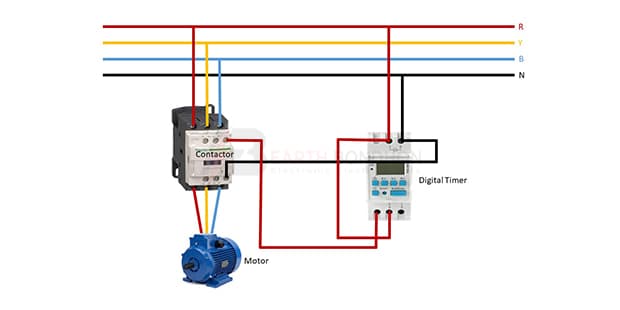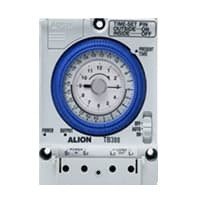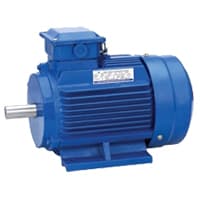Timer and Contactor Wiring Diagram:
This diagram shows how to make Timer and Contactor Wiring Diagram. In this circuit, we use a magnetic contactor, a three-phase motor, and a digital timer. First, we need to connect the magnetic contactor then connect the digital timer and 3-phase motor. This circuit is very simple and easy to make. If you want to know more about this circuit please check our youtube video below the post.
Advertisements
Components needed For this Project:
You can get the components from any of the sites below:
- Magnetic Contactor 25A [See Buy Click Amazon]
- Digital Timer 220V AC [See Buy Click Amazon]
- 3 Phase Motor (5 HP) [See Buy Click Amazon]
*Please note: These are affiliate links. I may make a commission if you buy the components through these links. I would appreciate your support in this way!
Advertisements
Components used to make the Timer and Contactor Wiring Diagram:
A magnetic contactor is an electromagnetic switching device. It is generally used for controlling 3-phase Motors. The operation of a magnetic contactor is similar to that of a Relay. but a relay is used for low-power or low-voltage connections, and a magnetic contactor is used for high-power or high-voltage connections. As soon as the supply is applied to the magnetic contactor coil. its normally open contacts are closed and normally closed contacts are opened and the associated devices are also operated. This is how a magnetic contactor works.
02. Timer:
A timer is a type of time-switching device that controls and controls Electrical circuits and electrical and electronic devices through time setting (on/off). The timer is basically 8-pin. Like other controlling devices the timer has a coil and when this coil is magnetized, the timer works on/off. The timer has 2 common ends and each common end has normally close and normally open options. When the timer is set by time, the timer trips at the end of that time and turns the common is normally closed (on) to open (off) and normally open (off) to close (on). This is how the timer works.
A 3-phase electric motor uses a 3-phase Power Supply to Convert Electric Energy into Mechanical Energy. It contains four Wires (Three hot Wires and one Neutral Wire) and Uses 3 Alternating Currents of the Same Frequency. Since it Generates a Rotating Magnetic Field, it does not need a Capacitor for the Startup. Some 3-phase Motors are Reversible, Which Means they can serve as Generators by Turning Mechanical Energy into Electrical Energy.
Thank You for visiting the website. Keep visiting for more Updates.
Frequently asked questions
A contactor is a device that is used to control the supply of a 3-phase power supply in an electrical circuit diagram. The contactor's role is to switch on or off the power supply to its connected output load.
A contactor is a relay that is used for switching the power. They usually handle very heavy loads like an electric motor, lighting, and heating equipment and, so on. Contactors are controlled by a circuit with very little power even though their output is used for switching very high loads.
The three major parts of a contactor or relay are the coil, the contacts, and the enclosure. Coil, The coil is an electromagnetic coil that, when energized, generates a magnetic field to attract the contacts or close the circuit diagram.
The symbol for a contactor is typically represented as a box with a diagonal line through it, which indicates that it is a contactor. Contactors are commonly used in electrical circuits to control the flow of electricity to a load.
There are usually 2 contactors to each switch, marked as a line and terminal. The line (L) contains the voltage feed while the terminal (T) is connected to the electrical of the device being controlled.
Read more Single Phase Wiring
What is a kilowatt-hour (kWh) | kwh formula | What does kwh mean
Introduction to Electrical Units and CircuitskW and kWh on your electricity bill As your home uses electricity during...
What is the Difference Between kVA | What does KVA mean | kVA formula
Difference Between KVA ExplainedWhat does KVA Mean? There are technical terms aplenty when it comes to generators, and...
Power Factor | Power Unit | Energy | Electricity Unit
Power factor definition | Calculating Power FactorPower Factor Values In a purely resistive circuit, the power factor...




0 Comments